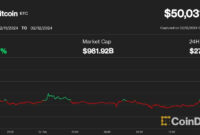Reasons Ethereum’s Price Will Increase With the Upcoming Merge – cryptokinews.com
Ethereum’s (ETH) long-awaited upgrade—commonly referred to as “the merge” and “Ethereum 2.0”—could be the most important event in cryptocurrency markets this year.
The final phase of the merge begins in only a few days, as a massive upgrade to the leading altcoin’s network is slated to begin in mid-September.
In preparation, there’s been a 10% increase in derivatives trading volume of ETH over the month of August. The No. 2 crypto even surpassed Bitcoin in derivates volume.
Some analysts suspect the overall supply of Ethereum could go down as a result of the merge, which would increase the cryptocurrency’s value for those already holding it. These factors have led to a great deal of volatility and excitement in the days leading up to the Ethereum 2.0 transition. The leading altcoin is up nearly 15% over the last five days to around $1,640.
One single transaction using Bitcoin can light up the 160-storied Burj Khalifa. While it’s no match to the world’s tallest building, an Ethereum transaction too takes as much energy it needs to light up the Leaning Tower of Pisa.
Most cryptocurrencies in general generate electricity bills that equals the collective consumption of a small country. This is because mining of crypto requires using high power computers that need tons of electricity.
Ethereum with its ‘big merge’ and the launch of Ethereum 2.0 intends to change that.
What is Ethereum?
As the largest cryptocurrency behind bitcoin (BTC), ether (ETH) has a current market cap of over $180 billion.
Ethereum is a decentralized blockchain powered by its native currency, ether. Ethereum is responsible for the creation of smart contracts, which power many of the most most important crypto initiatives, such as decentralized finance (DeFi), decentralized apps (dapps) and non-fungible tokens (NFT).
Ethereum is currently powered and secured by a proof-of-work (PoW) consensus mechanism, which incentives network participants to solve arbitrary mathematical puzzles. Under the current PoW system, Ethereum miners earn 2 ETH per block mined, which occurs approximately every 10-19 seconds.
What’s Ethereum Merge?
This blockchain technology which is known for executing smart contracts, is taking the next big step towards efficiency in general, in addition to energy efficiency, costs and others.The Merge will divide the Ethereum network into smaller data blocks, making more transactions at greater speed in a process known as sharding. Ethereum 2.0 in its new avatar, can bring back some of the developers that this blockchain lost, most experts hope.
“Developers building web 3 projects find Ethereum expensive as it asks for higher gas fees. But post Ethereum 2.0, these developers can even come back to Ethereum. The transition to proof-of-stake is expected to reduce Ethereum’s energy consumption by 99.95%,” said Naimish Sanghvi, co-founder of decentralized application MultiSender.
How the merge will affect supply
Investors have long believed that the 21 million BTC supply cap of bitcoin is one of the strongest features of the most popular cryptocurrency, unlike any fiat currency in existence. Investors have often referred to bitcoin as “digital gold” and have allocated capital to bitcoin based on its tokenomics and supply transparency.
Ethereum is currently unlike bitcoin in this aspect. The current ether inflation rate has been steadily increasing since the launch of the project, a topic that many crypto enthusiasts have often pointed out as a negative feature of Ethereum.
Ethereum has historically had a much higher inflation rate than Bitcoin and no theoretical cap on total supply. With the planned upgrade, the fundamentals of Ethereum are likely to change.
The Ethereum upgrade will likely decrease the total ETH supply and provide token holders with an opportunity to stake their tokens. Because of the expected yield generated through staking, it is likely that the total market interest in Ethereum will increase as an investor can participate in income generation for holding their ETH.
A decrease in the total supply of ETH will likely be seen as a positive change to the second largest cryptocurrency.
Christine Kim, research analyst at Galaxy Digital said, “Supply should contract rather than expand over time. And so I think that’s a huge boost to Ethereum’s investment narrative as a store of value and as a hedge against inflation.”
Increased participation
In order to successfully mine on a PoW blockchain, an individual has to make a significant capital allocation. Running a PoW mining operation is cost intensive, often requiring the purchase of hardware, power-supply upgrades, and logistical solutions.
The transition from PoW to PoS will reduce the capital barrier needed to secure Ethereum, allowing many new market participants to stake their ETH and help secure the network.
The current cost to run an Ethereum node is approximately $36,000 USD (per current prices), allowing retail investors to pool their ether and profit from staking.
Ethereum Merge Price Prediction
The merge has been in the works for years, but nobody knows exactly how Ethereum 2.0 will pan out for users. Few changes of this scale have ever been attempted in the world of crypto before.
The merge aims to convert Ethereum from a proof-of-work protocol to proof of stake. The former uses crypto miners to add blocks to the blockchain, while the latter uses validators staking ETH to get a chance to extend the blockchain.
This conversion to proof of stake will be accomplished by merging Ethereum’s Mainnet with the system’s Beacon Chain. This is a proof-of-stake chain that’s been running on the Ethereum network since December 2020. Launching the Beacon Chain was the first step in the merge.
The next step will be Ethereum’s Bellatrix upgrade on Sept. 6. The remaining step in the process, referred to as the Paris upgrade, should begin to be implemented sometime around Sept. 15.
As long as nothing too disruptive happens during the upgrade process, many crypto insiders believe investors should expect to see positive returns as a result of the merge.
Updating an entire blockchain protocol amid heavy use remains a very tough job. An estimated 1.3 million transactions occur on the Ethereum network daily.
Ben McMillan, co-founder and chief investment officer of IDX Digital Assets, says that the options markets are very bullish on the merge. Although, he also says that he’s nervous there could be a “buy the rumor, sell the news” mentality going on, which could hurt Ethereum’s price in the short term following the merge.
If the merge goes smoothly, some investors could wind up liquidating their positions following implementation. After the merge, these investors might believe they’ve already capitalized on its value, and they could then sell their positions and cause short-term price decline.
Anthony Scaramucci, founder and managing partner at global asset management firm Skybridge Capital, told CNBC earlier this month that a lot of traders will “probably sell on news of the merger,” but cautioned against that, saying Ethereum was a great long-term investment.
Ethereum Price Trend
The merge should definitely produce short-term effects on the price of Ethereum. Traders may want to watch these developments closely. But the question for other investors will be where Ethereum will go in the long run.
Nobody can know exactly where the price of ETH will be by the end of the year. McMillan predicts Ethereum will hit a price point “north of $2,000” before late 2022.
Obviously, this is a bullish price prediction, and a handful of factors could affect it.
In addition to the merge, many crypto insiders believe investors might want to look at macroeconomic factors like inflation and government regulations of cryptocurrencies to help determine their investment strategies for the rest of this year.
Cryptocurrencies haven’t proven to be the hedge against inflation that some early Bitcoin adopters claimed. Instead, many cryptocurrencies, and ETH, in particular, have begun moving in tandem with high-risk stocks like the tech-heavy Nasdaq.
This means macroeconomic factors such as inflation could continue exerting pressure on ETH’s overall price. In an inflationary environment, many investors retreat to commodities like oil and gold and tend not to be as interested in riskier investment vehicles like tech stocks and cryptocurrencies.
Many eyes are also on the U.S. government and other international regulators for upcoming legislation, as regulations can drastically affect cryptocurrency prices.
Ethereum Volatility
Ethereum, like all cryptocurrencies, has proven to be an extremely volatile investment, and rapid price fluctuations can be set off by the smallest bits of news.
Reaching a high of more than $4,600 in November 2021, ETH is now down more than 64% to approximately $1,600.
Although McMillan does foresee ETH breaking through the psychological barrier of $2,000 again before the end of this year, the cryptocurrency’s volatility can make those kinds of price predictions difficult to determine with any accuracy.
McMillan advises investors to consider cryptocurrencies like Ethereum, similar to Nasdaq stocks in the late 1990s. “Be cognizant of short-term risks,” he says, but keep an eye on where you believe the cryptocurrency will be in five to 10 years.
Of course, with any high-risk investment like cryptocurrency, investors should remain aware of risks and not invest more than they can afford to lose.
Ethereum and other cryptocurrencies are volatile, high-risk investments that can quickly shift directions. Investors must always do their due diligence and be prepared for the volatile nature of these investments.
Faster transactions
Ethereum 2.0 aims to process 100,000 transactions per second that would significantly reduce the gas fees – the fees that developers or crypto users pay the blockchain to complete a transaction.
After sharding, it can fit in more transactions, that’ll make it faster and easier to access. Since more users can use it, easily and going by the ‘economies of scale’ concept, it will turn cheaper too.
Less Gas Prices
Ethereum currently can only process 30 transactions per second and the cost of transaction or gas fees can go as high as $100. Less number of transactions means higher gas fees.
As the throughput increases after the merge, it can fall as low as $0.02 post-rollups, according to Vitalik Buterin, founder of Ethereum Network.
Mining more environmentally friendly, less energy intensive
According to the Ethereum Foundation, a single Ethereum 2.0 transaction will consume electricity equal to about 20 minutes of TV (35 watts). Buterin aims to reduce the energy consumption by 99.95%.
Originally, to make a transaction, one requires high powered computers in order to solve the complex mathematical equations to earn rewards for mining or validating crypto transactions.
Ethereum 2.0. requires much less energy to verify crypto transactions as it does not require validators to solve these complex equations and does not need hardware.
More decentralization
Sharding, dividing the Ethereum blockchain into multiple data blocks will lead to more creators flocking to Eth 2.0 for building projects. A majority of web3 projects are based on Ethereum blockchain.
Its applications are wide-ranged —making banking more customer-centric, redefining how digital payments are done without data being owned by third parties. It also aims to reduce reliance on fiat money.
Better security
The Solana hack that wiped over $8 million from user assets, shows how vulnerable wallets are, to hacks. The switch to proof-of-stake for Ethereum will make it incredibly complex and expensive for hackers.
While users can consume lesser power, hackers will need a lot more energy to crack it, making it extremely energy intensive. Every validator on the network will have a traceable address.
There is much to look forward to from the merge, but it won’t produce immediate results. There would be stages that Ethereum 2.0 will have to go through to achieve its full potential.
Buterin said at Ethereum Community Conference on July 22 that Ethereum will only be about 55% complete after the ‘merge’. The complete merge will take place some time in 2023.


